We believe that the autobiographical extracts were published in the introduction to a second edition of Elizabeth Bowen’s first collection of short stories – Encounters – published in 1949. We have photocopies from Encounters, which were displayed in an exhibition in 1980 about School Days. Additional information is from LHS Newsletter 98, December 1995, and from ‘Bowen’s Court’, Elizabeth Bowen’s account of her ancestral home, published in 1942, with a revised edition in 1964.
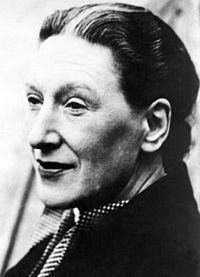
Elizabeth Bowen – Wikipedia
Elizabeth Bowen was born in Dublin in 1899, the only daughter of Henry Charles Cole Bowen and Florence Isabella Colley, who had married in 1890. Both families were part of the extensive Anglo-Irish community. Elizabeth’s early childhood was spent partly in Dublin and partly at the ancestral home, Bowens Court, County Cork, which she described in Seven Winters (1942).
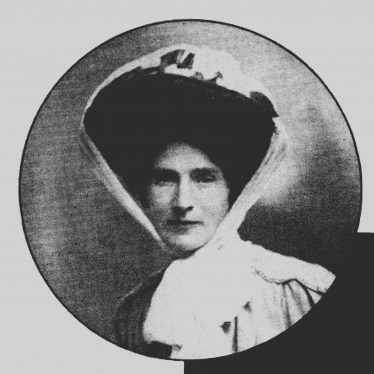
Florence Isabella Colley Bowen – from ‘Bowen’s Court’
After her father became ill in 1907, she and her mother Florence Colley Bowen moved to England, eventually settling in Hythe. Her mother died of cancer in the summer of 1912, soon after her aunt Constance, a woman doctor, had died of consumption and her uncle Eddy Colley had gone down with the Titanic.
Arrival in Harpenden
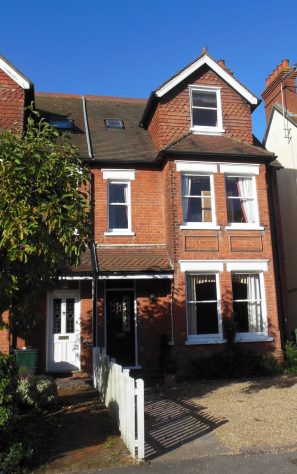
South View, (14) Spenser Road, home of Rev. W Colley from c.1907-1914
Elizabeth describes how she came to Harpenden, where her aunt, Laura Colley, was housekeeper to her brother, the Revd Wingfield Colley (Uncle Winkie), curate in charge of St John’s Church, and living in ‘South View’, Spenser Road:
“The problem I represented had been solved in advance: I was to go to Aunt Laura. My mother had made the arrangement with loving optimism, and Aunt Laura accepted it as a vocation. Considering all she had been through that three-death year, might not having me to cope with have been the finish? As against that, may the challenge have braced her up? At all events, the energy, ingenuity and briskness with which she rose to the occasion did her credit in the eyes of the rest of the family, inclined till then to refer to her as ‘poor Laura’, on the grounds of her being a shade sentimental, unmarried, and muddle-headed, and of having been down-trodden by her more brilliant sisters – not least Florence.
“The actual sufferer under the arrangement could have been Uncle Wingfield, the angelic unmarried clergyman brother for whom, at this time, at Harpenden, she kept house. His prolonged bachelor state was said to be due to her zealous chaperonage. He, a winning, delightful man, was with regard to some aspects of life pathologically shy, bashful, prone to cramping embarrassments. Still being a curate, though an important one, he did not as yet qualify for a parsonage: South View, a semi-detached villa, already contained, to a nicety, his entourage: Aunt Laura, their ‘working housekeeper’ Miss Kilby, and the dog Susan. The wedging-in, on top of these, of a girl supposedly on the verge of puberty, could have spelled for him more than special discomfort. His sweetness of nature, however, triumphed. He was forever devising ‘surprises’ for me: treats, gifts, jokes, outings. All of these were accompanied by an understanding speechlessness, which I valued. If any gout or driblet of love – of affection, even, was during that time to be wrung from my petrified heart, it was for him. … But South View was in great part wasted on me. I did not desire “a home life”. The fact was it would have been better to send me straight to boarding-school. I made do by devoting myself to Harpenden Hall, where I spent about ten hours of each day.”
Miss English’s boarding school
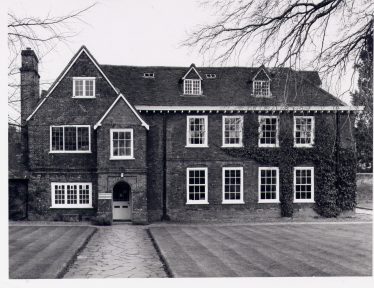
Harpenden Hall in early – RCHM 1973,Crown Copyright
Of her time at Harpenden Hall School (between 1912 and 1914) she wrote: “Getting me there had been a coup of Aunt Laura’s. The school did not want to take any more day-girls: in intention, since it began, it had been a boarding-school, and Miss English wished it to keep that character. However, her objections were overborne. Two or three weekly boarders were there, from neighbouring parts of Hertfordshire; the boarders all, but all, came from London. At Lindum [in Hythe, ed?] day-school pure and simple, my fellow-girls had necessarily been ‘locals’; one could track any one of them back to her home surroundings – which in the end could wither one’s interest.
“Londoners were birds of another feather. In uniform, they had the look of being in disguise – who knew what they wore in the capital city? They were ever so slightly sophisticated, compared to me and my fellow Harpenden day-girls, but not depraved. They were known in the village, drifting shopping around in their Hall tunics, as being old-for-their-ages.
“The uniform itself I particularly liked – I was all for it, and saw it likely to be a becoming one: brown tunic box-pleated into a square yoke (exactly as today) with a blue-and-white striped shirt to be worn under it, and a brown tie to be knotted over the shirt.”
First impression of Harpenden Hall
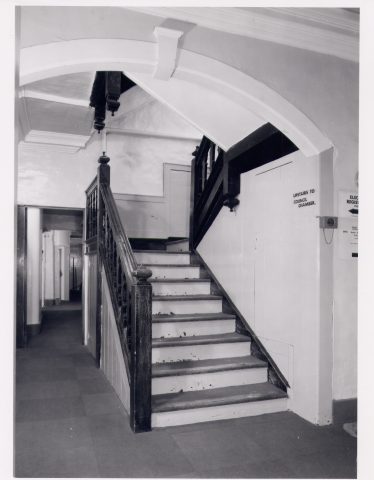
Staircase in Harpenden Hall – RCHM 1973 Crown copyright
Elizabeth entered Harpenden Hall School at mid-term in 1912. “Harpenden Hall, second of the three I went to, was the most comely. Built, I should think, in the late seventeenth century, low, long, graceful and solid, ‘The Hall’ stood a short way back from the bicycling Common, on to which its windows gazed calmly out. In front, a paved path led to it, across lawns. It looked like a picture in a romantic novel, with a historic trend. (I did, in fact, and while I was still there, come on a black-and-white of it in a Louis Wain Annual, the great cat artist having resided in Harpenden during at least some of his years of fame*.) Indoors, the panelling of the main rooms was a dimmed ivory, the steps of the dark polished staircase were shallow. Where there was not panelling there were Morris wallpapers. This did not look like a school.
“But then, neither had Lindum done so, nor would Downe House [a school in Charles Darwin’s home ed]. Never had I the misfortune to be educated in any building erected for that purpose. Each of my schools being small (I believe by choice), each had established itself, with minimal changes, in what had till recently been a private house. The effect was a genial air of make-do – reassuring to an anti-scholastic child. At Harpenden Hall, the now desk-filled ivory parlours and bare-floored dining-room with ‘gym’ apparatus fitted around its walls kept the climate of earlier, ‘ordinary’ occupation. …
Pranks substituted for academic success
“When, every Monday morning, after school prayers, Miss English read out to the assembled school the form-orders of the preceding week, I came out bottom or bottom-but-one of mine. To save my face, I adopted a pose of being ‘lazy’. This must have been chagrining for Miss English, upon whom, I suspect, I had been imposed by Aunt Laura as eager, intelligent and ‘promising’. She had the grace to show herself as less vexed than puzzled.
“I would have been more galled by intellectual failure had I not had an alternative foot to stand on. I’d become a high-ranking initiator of school crazes, for which there was a constant demand at Harpenden Hall.
“Further ideas and impetus were needed: mine filled the bill. In a short time I had zealots excavating for secret passages, one at least of which was said, I can’t say by whom, to run from The Hall cellars to the doubtless bone-strewn vaults of the parish church away off at the other end of the village. The cellars were tortuous, endless, musty and, at a first reconnaissance, unrewarding: evidently our end of the passage had been blocked up by some malignant hand. We first tapped then beat about with our trowels along the walls, dislodging segments of scabrous plaster, harkening for ‘hollownesses’. I carried a tottering candle: the London boarders were to a girl equipped with electric torches, procured by them for nightly reading in bed – lurid historical romances – after Lights Out. This (had we known) not really very original Gothic experiment of ours was put a stop to: our bangings-about had been audible upstairs; the cobwebs and coal dust in which we emerged coated caused unfriendly remarks.”
[Elizabeth described other ventures, such as exploring the occult through Marjorie Bowen’s Black Magic (Bowen was the pseudonym of a prolific writer of ‘ historical romances, and supernatural horror stories.); collecting ‘perchy-birds’, miniature exotic bird costing 1 penny at a village shop; a range of dare-devil pranks including wall-top running and roof moutaineering on the steep roofs of the Hall; and blindfold bicycling.**]
Stories based on Harpenden memories
Her first published story, Breakfast, in the collection Encounters (1923), was written (in about 1919), perhaps at “the top of a house at Harpenden***; an attic of which the window was set high – only when I stood up could I see gardens, apple-trees, a blur of open country beyond. Between the sill of the window and the top of my table intervened a stretch of white wall-paper, lightly mapped by damp which must have percolated in through the outdoor tiling. This, as I sat at the table, was at eye-level. The short, rose-dotted curtains, which I had too often allowed to blow out into the rain, fretted over my head and smelled slightly musty. Now and then a voice from one of the gardens could be heard. The then Midland Railway main line ran at a right angle to the bottom of the road in which the house stood, from time to time an up or down express roared by; or, more disturbingly, a local train slowed down as it approached the station. I wrote by hand, as distinctly as was possible for me – as when at school, two of three years before, I had been making a fair copy of an essay.”
Notes
* We cannot yet trace any Harpenden connection with Louis Wain, but he spent the last years of his life, from 1930-1939 at Napsbury Hospital. The Museum of St Albans has samples of his work. http://www.stalbansoutofsightoutofmind.org.uk/page_id__26.aspx
** “Bicycling began for me when I was thirteen … Aunt Laura … was seldom off a bicycle… Once she considered me competent, she procured for me a glittering brand-new Raleigh. First riding the Raleigh, I dismounted, often simply to stand and look at it. This, my first machine, had an intrinsic beauty. And it opened for me an era of all but flying, which roads emptily crossing the airy, gold-gorsey Common enhanced.”
Visits to Harpenden in later years
*** The “house in Harpenden” was Innisfree, 9 Spenser Road. In 1914 Elizabeth’s uncle, Rev. William Wingfield Colley was appointed Rector of Blisworth in Northamptonshire; he and his sister moved there and in September Elizabeth was transferred to Down House School, after spending the summer, and the outbreak of war, with her father at Bowen’s Court.
After a while in Blisworth Mr Colley married. His sister then returned to Harpenden and lived at Innisfree, Spenser Road, a few houses away from her previous home. So when Elizabeth left school in the summer of 1917 Aunt Laura’s home was her base when in England. She wrote her first short story there [of the nearly 80 she published between 1923 and 1965]. Entitled “Breakfast” it became the opening story in her first published book Encounters issued in 1923. One of her books The Little Girls described an event as taking place in Kent, which was actually based on an incident at Harpenden Hall School during her time there.
Aunt Laura bought “Innisfree” in 1922 and lived there until her death in 1942. Her brother evidently visited from time to time. Theodora Wilson in her Journals recorded her appreciation that he conducted her mother’s funeral service at St John’s in March 1927 – “it was altogether a most comforting service” – and in 1928 he and his family lunched with the Wilson’s at River’s Lodge (Theodora’s Journals, p 202 & 211).
In 1935 Elizabeth was appointed her aunt’s sole executor, and on Laura Colley’s death in 1942 she sold 9 Spenser Road to Leonard Harrod, a founder member of the Local History Society – who by 1949 had moved to 41 Milton Road.
Elizabeth married Alan Cameron in August 1923 at Blisworth, where her husband worked and they took up residence there initially, before being mainly based in London and Ireland. She inherited Bowen’s Court on her father’s death in 1930. On her husband’s retirement early in 1952 they took up residence at Bowen’s Court, but their plans to make a go of the huge house were cut short by Alan’s sudden death in August 1952. Elizabeth remained at Bowen’s Court, but wrote: “For seven years I tried to do what was impossible. … By 1959 it had become inevitable that I should sell Bowen’s Court. The buyer was a County Cork man, a neighbour … Finally he decided that there was nothing for it but to demolish the house entirely. … It was a clean end. Bowen’s Court never lived to be a ruin.” (Bowen’s Court, 1942, pp.458-9).

No Comments
Add a comment about this page